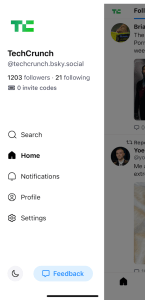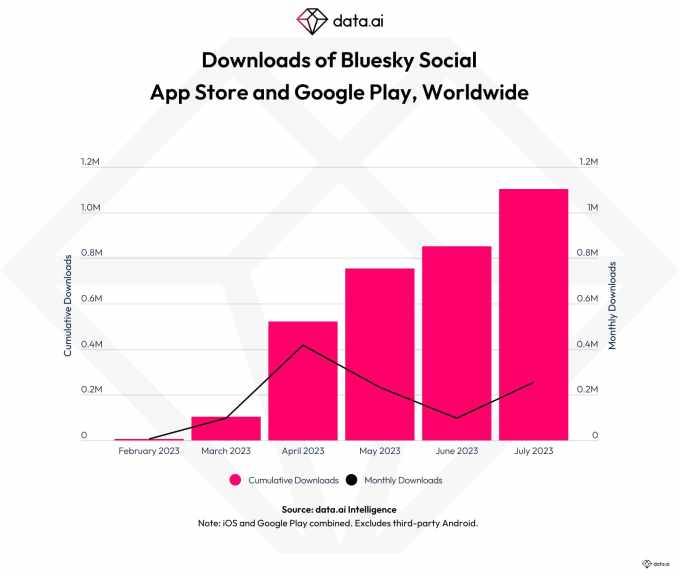Is the grass greener on the other side? We’re not sure, but the sky is most certainly bluer. It’s been over a year since Elon Musk announced his bid to buy Twitter, and those who opposed the sale have tried setting up shop on platforms like Mastodon, Substack Notes, T2… but none of these Twitter alternatives have really captured lightning in a bottle like Bluesky.
Bluesky remains invite-only in its beta, but as more people get on the site, the hype around it is growing — though as we know from apps like Clubhouse, the hype might not last forever. In the meantime, Bluesky now has over a million installs, according to estimates from data.ai. The new app sees about 8,300 first-tiime installs per day, on average. So many people are trying to get an invite that they’ve started popping up for sale on eBay (we would advise against making that purchase).
Here we answer the most common questions about Bluesky social:
What is Bluesky?
Bluesky is a decentralized social app conceptualized by former Twitter CEO Jack Dorsey and developed in parallel with Twitter. The social network has a Twitter-like user interface with algorithmic choice, a federated design and community-specific moderation.
Bluesky is using an open source framework built in-house, the AT Protocol, meaning people outside of the company have transparency into how it is built and what is being developed.
Dorsey introduced the Bluesky project back in 2019 while he was still Twitter CEO. At the time, he said Twitter would be funding a “small independent team of up to five open source architects, engineers, and designers,” charged with building a decentralized standard for social media, with the original goal that Twitter would adopt this standard itself. But that was before Elon Musk bought the platform, so as of late 2022, Bluesky is completely divorced from Twitter. Dorsey has even used Bluesky to express his dismay with Musk’s leadership.
Twitter is funding a small independent team of up to five open source architects, engineers, and designers to develop an open and decentralized standard for social media. The goal is for Twitter to ultimately be a client of this standard.
— jack (@jack) December 11, 2019
How do you use Bluesky?
Once invited, users create a handle which is then represented as @username.bsky.social as well as a display name that appears more prominent in bold text. If you’re so inclined, you can turn a domain name that you own into your username — so, for example, TechCrunch’s Darrell Etherington is known on Bluesky as @etherington.com.
The app itself functions much like a bare-bones Twitter, where you can click a plus button to create a post of 256 characters, which can also include photos. Posts themselves can be replied to, retweeted, liked and, from a three-dot menu, reported, shared via the iOS Share Sheet to other apps, or copied as text.
You can search for and follow other individuals, then view their updates in your “Home” timeline. There’s also a “What’s Hot” timeline, which surfaces engaging posts. User profiles contain the same sort of features you’d expect: a profile pic, background, bio, metrics and how many people they’re following. Profile feeds are divided into two sections, like Twitter: posts and posts & replies.
There is also a “Discover” tab in the bottom center of the app’s navigation, which offers more “who to follow” suggestions and a running feed of recently posted Bluesky updates.

Image Credits: Natalie Christman
How do I get invited to Bluesky?
New users receive one invite code every two weeks that they’re on the Bluesky app. The company monitors the social graph, giving users that are inviting trustworthy participants more invite codes to share.
Long-term, Bluesky says it views the invite code system as a piece of the open source tool it’s building to help server admins to curate and moderate their communities.
Who’s on Bluesky?
By beginning of July 2023, when Instagram’s Threads launched, Bluesky topped a million downloads across iOS and Android. Notable figures and organizations, from Representative Alexandria Ocasio-Cortez (D-NY) to Twitter exile NPR, have found a new home on Bluesky.

Image Credits: Data.ai
Does Bluesky work just like Twitter?
In many ways, yes. However, Bluesky does not yet have DMs or some advanced tools like adding accounts to lists. Additionally, Twitter does not use a decentralized protocol like ActivityPub or AT.
Bluesky was initially kicked off as a project convened by Jack Dorsey in 2019 when he was CEO of Twitter. But the social app has been an independent company since its inception in 2021.
Is Bluesky free?
Yes, but it is currently invite-only access.
How does Bluesky make money?
Bluesky’s goal is to find another means to sustain its network outside of advertising with paid services, so it can remain free to end users. On July 5, Bluesky announced additional seed round funding and a paid service that provides custom domains for end users who want ot have a unique domain as their handle on the service.
Is Bluesky decentralized?
Yes. Bluesky’s team is developing the decentralized AT Protocol, which Bluesky was built atop. In its beta phase, users can only join the bsky.social network, but Bluesky plans to be federated, meaning that endless individually operated communities can exist within the open source network. So, if a developer outside of Bluesky built their own new social app using the AT Protocol, Bluesky users could jump over to the new app and port over their existing followers, handle and data.
Is Bluesky customizable?
Yes. In May Bluesky released custom algorithms, or what it calls “custom feeds.” Custom feeds allow users to subscribe to multiple different algorithms that showcase different kinds of posts a user may want to see. You can pin custom feeds that will show up at the top of your timeline as different tabs to pick from. The feeds you pin, or save, is located under “My Feeds” menu in the app’s sidebar.
Is Bluesky on iOS and Android?
Yes. Bluesky rolled out to Android users on April 20 and was initially launched to iOS users in late February. The platform technically doesn’t have a web app yet, but if you’re logged in and go to staging.bsky.app, a whole new world will open up for you.
Are Bluesky posts really called ‘skeets?’
There is technically no name for posts, but internet users have adopted the name “skeets,” a portmanteau of “tweet” and “sky.” Users still widely refer to posts as “skeets,” despite protests from Bluesky CEO Jay Graber and others who don’t find the slang for semen amusing.
Why are people posting about the ‘hellthread’?
Alas, the hellthread. You had to be there. Basically, too many people responded to one thread, all the people in the thread’s notifications broke, the post became impossible to mute, the thread split off into a bunch of different sub-threads… It was chaos, and the developer who could fix it was off work until Monday — since it was the weekend — and he rightfully stood his ground and took his days off, especially since he had just been working tirelessly to get the block feature working. Oh, the joy of small startup teams! But this meant that the hellthread proliferated for the entire weekend. As prominent shitposter June wrote, “so far in day 3 of the hell thread i’ve seen nudes, a game of tic tac toe, love being found, what can’t the hellthread do.”
If you reply to the hellthread, you get trapped in the hellthread — that is, you start getting all the notifications, but you can’t scroll up that far to see the whole hellthread, which makes it sort of confusing, and also, how do you know if you’re in the main hellthread or a sub-thread? It’s easier to conceptualize the hellthread if you imagine it more like a helltree, with roots and branches of varying sizes and strength.
To paraphrase Bluesky CEO Jay Graber, every bug that exists long enough becomes a feature.
Oh, also, there was a duck bot that kept replying to the hellthread by saying “
 No
No  , no qwack…”
, no qwack…”
What’s the difference between Bluesky and Mastodon?
Though Bluesky’s architecture is similar to Mastodon’s, many users have found Bluesky to be more intuitive, while Mastodon can come off as inaccessible: Choosing what instance to join feels like an impossible task on Mastodon, and longtime users are very defensive about their established posting norms, which can make joining the conversation intimidating. To remain competitive, Mastodon recently simplified its sign-up flow, making mastodon.social the default server for new users.
Who owns Bluesky?
Though Jack Dorsey funded Bluesky and sits on the company’s board, he is not involved in day-to-day development. The CEO of Bluesky is Jay Graber, who previously worked as a software engineer for the cryptocurrency Zcash, then founded an event-planning site called Happening.
If you have more FAQs about Bluesky not covered here, leave us a comment below.







